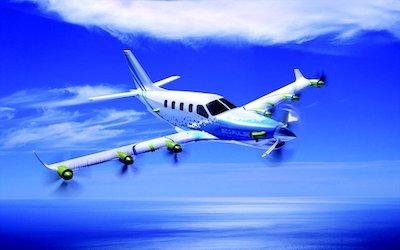Airplane Is A Distributed Hybrid Propulsion Aircraft Demonstrator
As part of their innovation strategies, Daher, Airbus and Safran have announced a collaborative partnership for the design and development of the wing-mounted EcoPulse distributed hybrid propulsion demonstrator with a maiden flight scheduled in 2022. Based on Daher’s TBM platform, this project, kick-started by CORAC (the French Civil Aviation Research Council) with support from DGAC (the French Civil Aviation Authority), will develop technologies that boost the environmental efficiency of aircraft and meet the future needs of the air travel industry.

The aviation industry as a whole is committed to the development of cleaner aviation.
“Reducing the environmental impact of aircraft is a priority for the industry as a whole. So it is with enthusiasm and determination that we welcome the opportunity to be part of this unique partnership alongside Airbus and Safran to succeed in the ambitious challenge set by CORAC. We are determined to make it a distinctive feature of the French aviation industry, and are certain that all stakeholders will unite around it,” said Nicolas Orance, SVP Aerospace and Defense BU at Daher.
The overall approach spans 3 areas of research and development:
- The distributed hybrid propulsion system will be provided by Safran;
- Airbus will have responsibility for the aerodynamic optimisation of the distributed propulsion system, the installation of high energy density batteries and the use of those batteries to power the aircraft;
- Component and systems installation, flight testing, overall analysis and regulatory construction will be undertaken by Daher using its TBM platform.
The purpose of this three-way collaboration is to validate technologies designed to reduce CO2 emissions, noise pollution, and create new uses for air transportation.
Safran will supply the entire EcoPulse distributed hybrid propulsion system (excluding batteries), consisting of a turbogenerator (a combined turbine and power generator), an electric power management system and integrated electric thrusters (or e-Propellers) including electric motors and propellers. The electric thrusters will be integrated into the EcoPulse wing and will provide propulsion thrust, at the same time as delivering aerodynamic gains (reducing wing surface area and wingtip marginal vortices, and therefore drag).
The installation of a distributed propulsion system on a TBM aircraft is an exciting opportunity to boost its efficiency, diversify its missions, reduce its environmental footprint and cut its operating costs.
“Safran has developed a technology roadmap for the installation of electric thrusters on aircraft. EcoPulse offers us an excellent opportunity to evaluate and identify the specific features expected by this market, particularly in terms of new hybrid propulsion aircraft projects. Safran intends to position itself as the market leader in this type of propulsion system by 2025,” said Stéphane Cueille, Head of R&T and Innovation at Safran.
Airbus will be involved in the aerodynamic modeling of the demonstrator, both to support configuration choices and to enable the development of flight control laws. All these considerations should make it possible to demonstrate the benefits of distributed propulsion, and provide the baselines for the design of optimised distributed propulsion aircraft in terms of methods, tools and outcomes.
“This distributed hybrid propulsion demonstrator is a very important step towards preparing the certification standards for a more electric aircraft. It also gives us the opportunity to improve our simulation models and consider their use on larger aircraft,” said Jean-Brice Dumont, Executive Vice President Engineering at Airbus.
(Image provided with Airbus news release)
 ANN's Daily Aero-Term (12.14.25): Local Airport Advisory (LAA)
ANN's Daily Aero-Term (12.14.25): Local Airport Advisory (LAA) Airborne 12.08.25: Samaritans Purse Hijack, FAA Med Relief, China Rocket Fail
Airborne 12.08.25: Samaritans Purse Hijack, FAA Med Relief, China Rocket Fail ANN's Daily Aero-Linx (12.15.25)
ANN's Daily Aero-Linx (12.15.25) Airborne 12.10.25: New Gulfstream, ATC Integrator, Outrageous FFZ User Fees
Airborne 12.10.25: New Gulfstream, ATC Integrator, Outrageous FFZ User Fees Airborne-NextGen 12.09.25: Amazon Crash, China Rocket Accident, UAV Black Hawk
Airborne-NextGen 12.09.25: Amazon Crash, China Rocket Accident, UAV Black Hawk



